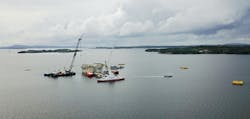Offshore staff
OSLO, Norway – Equinor and its partners plan to turn the Aasta Hansteen development facilities into a gas hub for other nearby finds in the Norwegian Sea, according to the Norwegian Petroleum Directorate’s latest house magazine.
Aasta Hansteen is due to start production later this year viaNorway’s first spar platform. At present the cylindrical hull is in the Digernes Sound near Stord on the Norwegian west coast.
The topsides is on its way from South Korea for mating with the hull off Stord.
Once completed, this will be the world’s largest spar, based on a vertical floating cylinder, with a total dry weight of around 70,000 metric tons (77,162 tons), excluding the heavy risers.
Equinor’s project director Torolf Christensen said the design provides capacity in terms of both weight and space on the platform to accommodate production from other discoveries made in the area.
“Our aim is to become a kind of center for a network of other finds,” he said. “That’ll give us more volume on the platform and extend its producing life.”
At present, there appear to be sufficient gas resources available around Aasta Hansteen to keep the installation onstream until about 2030.
“We have a lot in reserve, and an active licensee group which is exploring the surrounding area to discover more resources which we can phase in,” Christensen said.
“Our drilling contract with Transocean gives us opportunities to include four additional wells if we identify a similar number of good prospects in the area.
“That could happen either in the Aasta Hansteen license or in other acreage where one of the partners is operator. The rig is being used flexibly to add value for this field.”
Snefrid North will be produced through a tie-in to one of the existing subsea templates, while the Polarled gas pipeline that runs from Aasta Hansteen to Nyhamna on the coast could also support production further to the south, where tie-in points are already incorporated, or through a northward extension.
Aasta Hansteen is 300 km (186 mi) from land and 150 km (93 mi) from the nearest offshore infrastructure, on the Norne field. Conditions are rough, with 17 anchors needed to hold the platform in place.
Another first for the spar is the incorporation of condensate storage in the hull. This uses four tanks out of 52, which must be protected with a double bottom.
“Things got complicated here,” Christensen said. “We had to think about access, utilities, fire and gas alarms, ventilation and stairwells – all at the same time
A fiberglass communication cable has also been installed on the Aasta Hansteen field and connected via Norne.
Templates were positioned in 2015 – two with four slots each on the Luva and Haklang formations and one for a single well on Snefrid South.
The plan at present is to leave slots vacant on the Haklang template until a decision is taken on whether to use them. Snefrid North will be tied to Luva by a flowline.
07/19/2018



